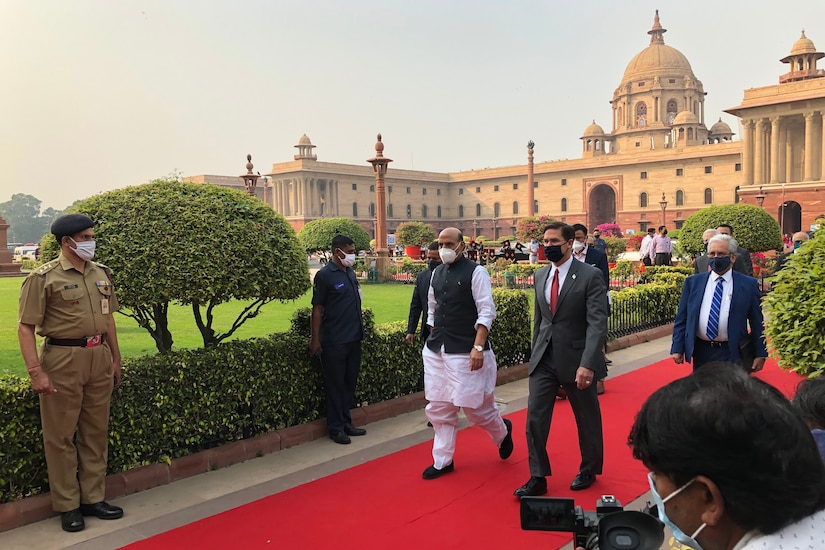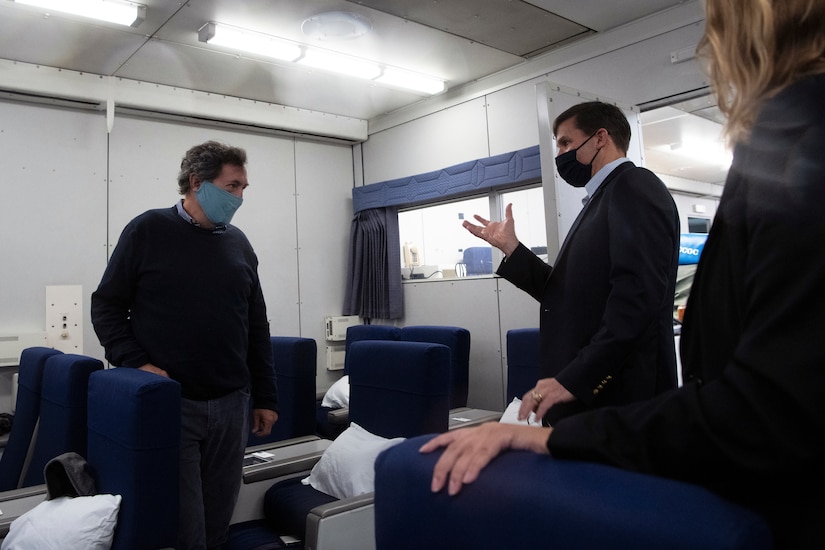A Marine provides security around an MV-22 Osprey during aerial embarkation drills in Kuwait, Oct. 22, 2020.
Providing up-to-date information, news and original content on American Military issues.
A Marine provides security around an MV-22 Osprey during aerial embarkation drills in Kuwait, Oct. 22, 2020.
Air Force Senior Airman Enrique Cabrera prepares munitions for Global Thunder at White Air Force Base, Mo., Oct. 20, 2020. The annual field training and command post exercise also assess joint operations readiness.
The guided missile destroyer USS Halsey conducts routine operations in the Pacific Ocean, Oct. 24, 2020.
U.S. Marines demonstrate the use of a High Mobility Artillery Rocket System to U.S. sailors at Camp Fuji, Japan, Oct. 21, 2020.
Marines in Polaris M-RZR vehicles exit an aerial raid training operation at Marine Corps Base Camp Pendleton, Calif., Oct. 20, 2020.
Marines and sailors train with European troops during Operation Lisa Azul at Naval Station Rota, Spain, Oct. 21, 2020.
An Army paratrooper descends over the Malemute Drop Zone at Joint Base Elmendorf-Richardson, Alaska, Oct. 22, 2020.
An Army M142 High Mobility Artillery Rocket System launches ordnance during Exercise Red Flag-Alaska at Fort Greely, Alaska, Oct. 22, 2020. The exercise focuses on rapid infiltration and exfiltration to minimize the chance of a counterattack.
Soldiers board an Army CH-47 Chinook helicopter during a Joint Force Entry exercise at Fort Polk, La., Oct. 22, 2020. Soldiers certified for deployment to build interoperability with key allies and partners.
Oct. 26, 2020
Secretary of Defense Mark T. Esper met today with Indian Minister of Defense Rajnath Singh ahead of the U.S.-India 2+2 Ministerial Dialogue in New Delhi, India. Secretary Esper and Minister Singh applauded the strength of the defense relationship between the United States and India, and reinforced their commitment to deepening military-to-military cooperation, including joint-service cooperation; increasing secure communications capabilities; and enhancing mutual logistics engagements. Secretary Esper and Minister Singh commended the conclusion of the Basic Exchange and Cooperation Agreement during the visit, and welcomed the expansion of information-sharing. From collaborating on emerging technologies to advancing defense trade priorities, Secretary Esper and Minister Singh agreed to continue to work in partnership to address pressing global security challenges.
Air Force Airman 1st Class Bryant Vides-Perlera pulls chocks beside an RQ-4 Global Hawk remotely piloted aircraft as it’s towed across the flightline at Grand Forks Air Force Base, N.D., Oct. 23, 2020.
Air Force Staff Sgt. Devin Mazza, a tactical air control party specialist assigned to the 3rd Air Support Operations Squadron, prepares to jump from a C-17 Globemaster III aircraft during nighttime airborne training at Joint Base Elmendorf-Richardson, Alaska, Oct. 20, 2020. Special warfare airmen assigned to the squadron conducted the training to demonstrate short-notice mission readiness in the Arctic environment.
Navy Petty Officer 3rd Class Jonathan Chamian signals from the forecastle aboard the guided-missile destroyer USS John S. McCain to the dry cargo and ammunition ship USNS Alan Shepard during a replenishment in the South China Sea, Oct. 22, 2020.
An Air Force F-35A Lightning II flies with two Royal Australian Air Force F-35As over the Grand Canyon in Arizona during a flight to celebrate the partnership between the two services, Oct. 8, 2020.
Sailors aboard the ballistic missile submarine USS Henry M. Jackson recover a payload delivered by a helicopter in the Pacific Ocean near the Hawaiian Islands, Oct. 20, 2020.

"Two-plus-two" refers to the U.S. secretary of state and defense secretary meeting with their counterparts in India. This is the third meeting at this level, and it's the second for Defense Secretary Dr. Mark T. Esper.
The U.S. and Indian relationship has warmed considerably and the increased frequency and candor of these meetings is a reflection of this. "The two-plus-two ministerial will serve as a capstone to review our many accomplishments, as well as lay down next steps for the U.S.-India comprehensive, global strategic partnership," an administration official said.
India and the United States cooperate in economic, diplomatic and information areas, and the military cooperation between the two nations is also increasing.
Given China's increasingly aggressive behavior from Africa to the Himalayas to the South China Sea to Oceania, it is crucial that like-minded states oppose Chinese Communist Party efforts to reshape the international order in its favor.
China has committed to changing the international order put in place in the wake of World War II that stopped major power confrontation. The international order is based on respect for the sovereignty of all nations, large and small. The existing order has benefited all nations of the Indo-Pacific region including China, which has grown to be the world's second-largest economy under the protections of the existing system.

Indonesia, Sri Lanka, Vietnam, Brunei, Malaysia, Singapore and more are affected by the Chinese push to change the norms in the region. U.S. treaty allies — including Australia, New Zealand, Japan, South Korea, Thailand and the Philippines — are also affected. The Chinese actions have raised alarms across the region, and they are pushing the democracies to work together to oppose the Chinese vision for the Indo-Pacific.
Cooperation between the United States and India goes beyond mere opposition to China. The U.S. and Indian militaries cooperate in humanitarian relief missions. They share intelligence and information on terror groups, and they work together to oppose transnational criminal groups.
India and the U.S. will discuss pandemic response, maritime security, cybersecurity, quality infrastructure, counterterrorism and other areas.
The defense cooperation between the two nations is foundational. "The defense relationship with India right now is currently at its best in recent memory," said another administration official participating on the call. "The progress we've made since India became a major defense partner in 2016, is remarkable."
Investments in the bilateral defense relationship from both sides in previous years have set the foundation for the accomplishments this year that may be announced in the coming weeks. "We solidified our strategic alignment and confirmed the need to work together and promote a free and open Indo-Pacific for the benefit of all countries in the region," the official said.

Broadly the U.S. and Indian defense ministers will discuss regional security cooperation. "We're working to enhance maritime security across the Indian Ocean region by coordinating security cooperation and building partner capacity with regional countries," the administration official said. "India announced just this week that it was inviting Australia, along with the U.S .and Japan, to the Malabar naval exercise in November.
"This invitation signals not only a strategic convergence between quadrilateral partners, but a recognition that regional security requires strengthening allies and partnerships and working multilateral on issues of mutual concern."
The U.S., India relationship requires information sharing. The two nations have an agreement that will allow for expanded geospatial information sharing between the respective armed forces. "We're also seeking to expand secure communication capabilities between our respective militaries, as well as between our foreign defense ministries," he said.
Military-to-military interactions are key. "We're working to build greater interoperability by increasing the sophistication of our combined exercises," the official said. The United States has placed liaison officers with Indian forces, and the Indians have placed officers at the U.S. Indo-Pacific Command and U.S. Central Command. "We also hope to confirm two additional Indian liaison officer placements in the near term to expand counterterrorism cooperation," he said.
The United States is interested in defense trade. Earlier this year, India acquired Apache and Seahawk helicopters, and the U.S. is seeking to advance sales for several other defense platforms to include fighter aircraft and UAVs, the official said.